History
A description of the chest pain (i.e., onset, nature, location, radiation, intensity, duration, associated features) and an enquiry about any associated symptoms or major risk factors for coronary artery disease (e.g., hypertension, diabetes, dyslipidemia, obesity, chronic renal insufficiency, smoking) are essential. Other risk factors for myocardial infarction (MI) include male sex, advanced age, and cocaine use in younger people.
Classically the pain is described as diffuse, severe, "heavy" or "crushing," located centrally in the chest, with radiation to the left arm or jaw and occurring at rest. However, it may be nonclassic by location (i.e., epigastric, jaw, arm, neck pain) or by nature (i.e., burning, throbbing, recent-onset indigestion [particularly if unrelated to meals], sharp or pleuritic chest pain, uneasiness).[75]Gulati M, Levy PD, Mukherjee D, et al; Writing Committee Members. 2021 AHA/ACC/ASE/CHEST/SAEM/SCCT/SCMR guideline for the evaluation and diagnosis of chest pain: a report of the American College of Cardiology/American Heart Association Joint Committee on Clinical Practice Guidelines. J Am Coll Cardiol. 2021 Nov 30;78(22):e187-285.
https://www.jacc.org/doi/10.1016/j.jacc.2021.07.053
http://www.ncbi.nlm.nih.gov/pubmed/34756653?tool=bestpractice.com
Associated features such as nausea, vomiting, dyspnea, palpitations, weakness, dizziness, lightheadedness, confusion, or vague abdominal symptoms are more frequent among patients with diabetes and in women and older people.[75]Gulati M, Levy PD, Mukherjee D, et al; Writing Committee Members. 2021 AHA/ACC/ASE/CHEST/SAEM/SCCT/SCMR guideline for the evaluation and diagnosis of chest pain: a report of the American College of Cardiology/American Heart Association Joint Committee on Clinical Practice Guidelines. J Am Coll Cardiol. 2021 Nov 30;78(22):e187-285.
https://www.jacc.org/doi/10.1016/j.jacc.2021.07.053
http://www.ncbi.nlm.nih.gov/pubmed/34756653?tool=bestpractice.com
Some patients can present with only these symptoms and without chest pain.
Investigations
ECG should be ordered as early as possible (i.e., within 10 minutes of presentation).[75]Gulati M, Levy PD, Mukherjee D, et al; Writing Committee Members. 2021 AHA/ACC/ASE/CHEST/SAEM/SCCT/SCMR guideline for the evaluation and diagnosis of chest pain: a report of the American College of Cardiology/American Heart Association Joint Committee on Clinical Practice Guidelines. J Am Coll Cardiol. 2021 Nov 30;78(22):e187-285.
https://www.jacc.org/doi/10.1016/j.jacc.2021.07.053
http://www.ncbi.nlm.nih.gov/pubmed/34756653?tool=bestpractice.com
[76]Writing Committee, Kontos MC, de Lemos JA, et al. 2022 ACC expert consensus decision pathway on the evaluation and disposition of acute chest pain in the emergency department: a report of the American College of Cardiology Solution Set Oversight Committee. J Am Coll Cardiol. 2022 Nov 15;80(20):1925-60.
https://www.sciencedirect.com/science/article/pii/S0735109722066189?via%3Dihub
If presentation is outside of the hospital, a prehospital ECG should be obtained as early as possible and sent to the receiving hospital.[3]Byrne RA, Rossello X, Coughlan JJ, et al. 2023 ESC Guidelines for the management of acute coronary syndromes. Eur Heart J. 2023 Oct 12;44(38):3720-826.
https://academic.oup.com/eurheartj/article/44/38/3720/7243210
http://www.ncbi.nlm.nih.gov/pubmed/37622654?tool=bestpractice.com
[5]Rao SV, O'Donoghue ML, Ruel M, et al. 2025 ACC/AHA/ACEP/NAEMSP/SCAI guideline for the management of patients with acute coronary syndromes: a report of the American College of Cardiology/American Heart Association Joint Committee on Clinical Practice Guidelines. Circulation. 2025 Apr;151(13):e771-e862.
https://www.ahajournals.org/doi/10.1161/CIR.0000000000001309
http://www.ncbi.nlm.nih.gov/pubmed/40014670?tool=bestpractice.com
Serial ECGs should be checked in patients with a normal initial ECG if there is a high clinical suspicion for myocardial ischemia.[2]Thygesen K, Alpert JS, Jaffe AS, et al. Fourth universal definition of myocardial infarction (2018). Eur Heart J. 2019 Jan 14;40(3):237-69.
https://academic.oup.com/eurheartj/article/40/3/237/5079081
http://www.ncbi.nlm.nih.gov/pubmed/30165617?tool=bestpractice.com
[75]Gulati M, Levy PD, Mukherjee D, et al; Writing Committee Members. 2021 AHA/ACC/ASE/CHEST/SAEM/SCCT/SCMR guideline for the evaluation and diagnosis of chest pain: a report of the American College of Cardiology/American Heart Association Joint Committee on Clinical Practice Guidelines. J Am Coll Cardiol. 2021 Nov 30;78(22):e187-285.
https://www.jacc.org/doi/10.1016/j.jacc.2021.07.053
http://www.ncbi.nlm.nih.gov/pubmed/34756653?tool=bestpractice.com
If the ECG shows ST-segment elevation, the patient should be urgently assessed for reperfusion therapy.[5]Rao SV, O'Donoghue ML, Ruel M, et al. 2025 ACC/AHA/ACEP/NAEMSP/SCAI guideline for the management of patients with acute coronary syndromes: a report of the American College of Cardiology/American Heart Association Joint Committee on Clinical Practice Guidelines. Circulation. 2025 Apr;151(13):e771-e862.
https://www.ahajournals.org/doi/10.1161/CIR.0000000000001309
http://www.ncbi.nlm.nih.gov/pubmed/40014670?tool=bestpractice.com
ST depression in two or more leads V1-V4 should be strongly considered as a posterior STEMI.[Figure caption and citation for the preceding image starts]: 12-Lead ECG with ST-segment elevation lead V1 to V4From the personal collection of Dr Mahi Ashwath; used with permission [Citation ends].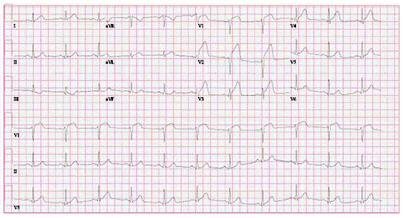 [Figure caption and citation for the preceding image starts]: 12-Lead ECG with ST-segment elevation in the inferior leads (II, III, and aVF)From the personal collection of Dr Mahi Ashwath; used with permission [Citation ends].
[Figure caption and citation for the preceding image starts]: 12-Lead ECG with ST-segment elevation in the inferior leads (II, III, and aVF)From the personal collection of Dr Mahi Ashwath; used with permission [Citation ends].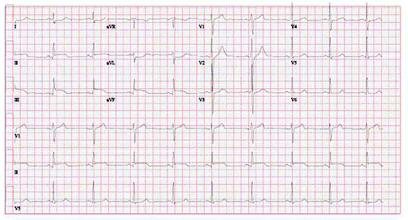 [Figure caption and citation for the preceding image starts]: 12-Lead ECG with normal ST segments and without any abnormal Q wavesFrom the personal collection of Dr Mahi Ashwath; used with permission [Citation ends].
[Figure caption and citation for the preceding image starts]: 12-Lead ECG with normal ST segments and without any abnormal Q wavesFrom the personal collection of Dr Mahi Ashwath; used with permission [Citation ends].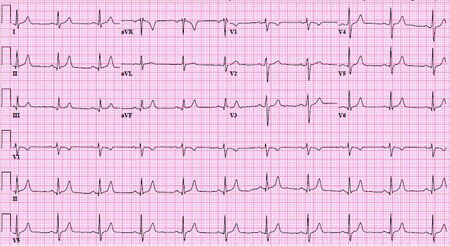 [Figure caption and citation for the preceding image starts]: 12-Lead ECG 1 week later with borderline anterolateral ST-elevation and reciprocal ST-depression in the inferior leads; also noted is the poor R-wave progression and the presence of septal Q wavesFrom the personal collection of Dr Mahi Ashwath; used with permission [Citation ends].
[Figure caption and citation for the preceding image starts]: 12-Lead ECG 1 week later with borderline anterolateral ST-elevation and reciprocal ST-depression in the inferior leads; also noted is the poor R-wave progression and the presence of septal Q wavesFrom the personal collection of Dr Mahi Ashwath; used with permission [Citation ends].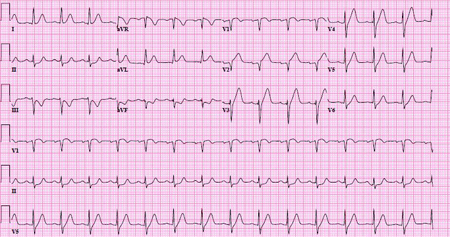 [Figure caption and citation for the preceding image starts]: 12-Lead ECG 1 hour later with obvious anterolateral ST-elevation and reciprocal ST-depression in the inferior leads, absence of anterior R waves, and the development of anterior Q wavesFrom the personal collection of Dr Mahi Ashwath; used with permission [Citation ends].
[Figure caption and citation for the preceding image starts]: 12-Lead ECG 1 hour later with obvious anterolateral ST-elevation and reciprocal ST-depression in the inferior leads, absence of anterior R waves, and the development of anterior Q wavesFrom the personal collection of Dr Mahi Ashwath; used with permission [Citation ends].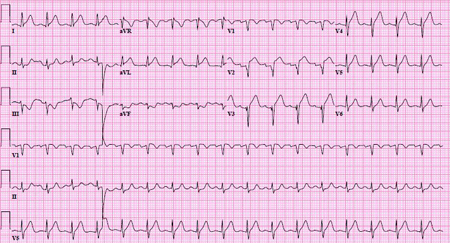 [Figure caption and citation for the preceding image starts]: 12-Lead ECG 3 hours later with completed anterolateral infarct, absence of anterolateral R waves, and the development of anterolateral Q waves; the ST segments are returning to normalFrom the personal collection of Dr Mahi Ashwath; used with permission [Citation ends].
[Figure caption and citation for the preceding image starts]: 12-Lead ECG 3 hours later with completed anterolateral infarct, absence of anterolateral R waves, and the development of anterolateral Q waves; the ST segments are returning to normalFrom the personal collection of Dr Mahi Ashwath; used with permission [Citation ends].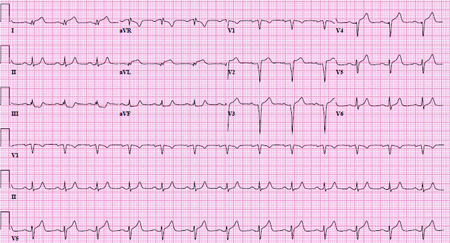 [Figure caption and citation for the preceding image starts]: 12-Lead ECG the next day with completed anterolateral infarct; ST segments are completely back to baselineFrom the personal collection of Dr Mahi Ashwath; used with permission [Citation ends].
[Figure caption and citation for the preceding image starts]: 12-Lead ECG the next day with completed anterolateral infarct; ST segments are completely back to baselineFrom the personal collection of Dr Mahi Ashwath; used with permission [Citation ends].
The definitive diagnostic test for STEMI is coronary angiography.[5]Rao SV, O'Donoghue ML, Ruel M, et al. 2025 ACC/AHA/ACEP/NAEMSP/SCAI guideline for the management of patients with acute coronary syndromes: a report of the American College of Cardiology/American Heart Association Joint Committee on Clinical Practice Guidelines. Circulation. 2025 Apr;151(13):e771-e862.
https://www.ahajournals.org/doi/10.1161/CIR.0000000000001309
http://www.ncbi.nlm.nih.gov/pubmed/40014670?tool=bestpractice.com
[  ]
For people with coronary artery disease, how do transradial and transfemoral approaches to diagnostic coronary angiography and percutaneous coronary intervention (PCI) compare?/cca.html?targetUrl=https://www.cochranelibrary.com/cca/doi/10.1002/cca.2167/fullShow me the answer Angiography can lead to immediate treatment as the vessel can often be opened and stented at the same procedure. If angiography is not immediately available, a further history should be taken to exclude contraindications to thrombolysis. Do not use coronary CT angiography in high-risk emergency department patients presenting with acute chest pain. Randomized controlled trials evaluating coronary CT angiography to diagnose coronary artery disease have been limited to those patients with acute chest pain at low or low-intermediate risk of ischemic events or mortality. Early CT may, however, be considered to rule out diagnoses such as aortic dissection or pulmonary embolism.[3]Byrne RA, Rossello X, Coughlan JJ, et al. 2023 ESC Guidelines for the management of acute coronary syndromes. Eur Heart J. 2023 Oct 12;44(38):3720-826.
https://academic.oup.com/eurheartj/article/44/38/3720/7243210
http://www.ncbi.nlm.nih.gov/pubmed/37622654?tool=bestpractice.com
[77]Society of Cardiovascular Computed Tomography. Five things physicians and patients should question. Choosing Wisely, an initiative of the ABIM Foundation. 2021 [internet publication].
https://web.archive.org/web/20221003082824/https://www.choosingwisely.org/societies/society-of-cardiovascular-computed-tomography
]
For people with coronary artery disease, how do transradial and transfemoral approaches to diagnostic coronary angiography and percutaneous coronary intervention (PCI) compare?/cca.html?targetUrl=https://www.cochranelibrary.com/cca/doi/10.1002/cca.2167/fullShow me the answer Angiography can lead to immediate treatment as the vessel can often be opened and stented at the same procedure. If angiography is not immediately available, a further history should be taken to exclude contraindications to thrombolysis. Do not use coronary CT angiography in high-risk emergency department patients presenting with acute chest pain. Randomized controlled trials evaluating coronary CT angiography to diagnose coronary artery disease have been limited to those patients with acute chest pain at low or low-intermediate risk of ischemic events or mortality. Early CT may, however, be considered to rule out diagnoses such as aortic dissection or pulmonary embolism.[3]Byrne RA, Rossello X, Coughlan JJ, et al. 2023 ESC Guidelines for the management of acute coronary syndromes. Eur Heart J. 2023 Oct 12;44(38):3720-826.
https://academic.oup.com/eurheartj/article/44/38/3720/7243210
http://www.ncbi.nlm.nih.gov/pubmed/37622654?tool=bestpractice.com
[77]Society of Cardiovascular Computed Tomography. Five things physicians and patients should question. Choosing Wisely, an initiative of the ABIM Foundation. 2021 [internet publication].
https://web.archive.org/web/20221003082824/https://www.choosingwisely.org/societies/society-of-cardiovascular-computed-tomography
Cardiac biomarkers (e.g., cardiac-specific troponins) should be ordered on presentation for any patient with chest pain and risk factors. High-sensitivity cardiac troponins are preferred.[75]Gulati M, Levy PD, Mukherjee D, et al; Writing Committee Members. 2021 AHA/ACC/ASE/CHEST/SAEM/SCCT/SCMR guideline for the evaluation and diagnosis of chest pain: a report of the American College of Cardiology/American Heart Association Joint Committee on Clinical Practice Guidelines. J Am Coll Cardiol. 2021 Nov 30;78(22):e187-285.
https://www.jacc.org/doi/10.1016/j.jacc.2021.07.053
http://www.ncbi.nlm.nih.gov/pubmed/34756653?tool=bestpractice.com
[76]Writing Committee, Kontos MC, de Lemos JA, et al. 2022 ACC expert consensus decision pathway on the evaluation and disposition of acute chest pain in the emergency department: a report of the American College of Cardiology Solution Set Oversight Committee. J Am Coll Cardiol. 2022 Nov 15;80(20):1925-60.
https://www.sciencedirect.com/science/article/pii/S0735109722066189?via%3Dihub
Cardiac troponin levels remain elevated for around 10 days, which can make it difficult to determine the time of myocardial injury.[78]Laugaudin G, Kuster N, Petiton A, et al. Kinetics of high-sensitivity cardiac troponin T and I differ in patients with ST-segment elevation myocardial infarction treated by primary coronary intervention. Eur Heart J Acute Cardiovasc Care. 2016 Aug;5(4):354-63.
https://academic.oup.com/ehjacc/article/5/4/354/5922208
http://www.ncbi.nlm.nih.gov/pubmed/25943557?tool=bestpractice.com
Patients with elevated troponin levels have a worse prognosis than those with normal troponin levels.[79]Setiadi BM, Lei H, Chang J. Troponin not just a simple cardiac marker: prognostic significance of cardiac troponin. Chin Med J (Engl). 2009 Feb 5;122(3):351-8.
https://journals.lww.com/cmj/fulltext/2009/02010/troponin_not_just_a_simple_cardiac_marker_.22.aspx
http://www.ncbi.nlm.nih.gov/pubmed/19236818?tool=bestpractice.com
[80]Association of troponin level and age with mortality in 250 000 patients: cohort study across five UK acute care centres. BMJ. 2020 Jun 18;369:m2225.
http://www.ncbi.nlm.nih.gov/pubmed/32554474?tool=bestpractice.com
Alternative causes for raised troponin levels should also be considered. These may be cardiac (e.g., myocarditis, aortic dissection, severe heart failure) or noncardiac (e.g., pulmonary embolism, impaired renal function, underlying sepsis).[81]National Institute for Health and Care Excellence. Recent-onset chest pain of suspected cardiac origin: assessment and diagnosis. Nov 2016 [internet publication].
https://www.nice.org.uk/guidance/cg95
It is important to remember that even with an alternative underlying cause, raised troponin may still indicate myocardial injury. Creatine kinase-MB fraction (CK-MB) and myoglobin are less sensitive and less specific and should not be ordered in the diagnosis of STEMI.[2]Thygesen K, Alpert JS, Jaffe AS, et al. Fourth universal definition of myocardial infarction (2018). Eur Heart J. 2019 Jan 14;40(3):237-69.
https://academic.oup.com/eurheartj/article/40/3/237/5079081
http://www.ncbi.nlm.nih.gov/pubmed/30165617?tool=bestpractice.com
[3]Byrne RA, Rossello X, Coughlan JJ, et al. 2023 ESC Guidelines for the management of acute coronary syndromes. Eur Heart J. 2023 Oct 12;44(38):3720-826.
https://academic.oup.com/eurheartj/article/44/38/3720/7243210
http://www.ncbi.nlm.nih.gov/pubmed/37622654?tool=bestpractice.com
[82]Society of Hospital Medicine – Adult Hospital Medicine. Eleven things physicians and patients should question. Choosing Wisely, an initiative of the ABIM Foundation. 2022 [internet publication].
https://web.archive.org/web/20230209055919/https://www.choosingwisely.org/societies/society-of-hospital-medicine-adult
[83]American Society for Clinical Pathology. Thirty five things physicians and patients should question. Choosing Wisely, an initiative of the ABIM Foundation. 2015 [internet publication].
https://web.archive.org/web/20230316185857/https://www.choosingwisely.org/societies/american-society-for-clinical-pathology
A basic metabolic panel and complete blood count should also be performed, and serum glucose and lipids should be measured. Cholesterol levels may be lowered by high catecholamine levels produced by the MI in its early phases, and serum lipids should therefore be repeated in 30-60 days.[84]Rott D, Klempfner R, Goldenberg I, et al. Cholesterol levels decrease soon after acute myocardial infarction. Isr Med Assoc J. 2015 Jun;17(6):370-3.
https://www.ima.org.il/MedicineIMAJ/viewarticle.aspx
http://www.ncbi.nlm.nih.gov/pubmed/26233997?tool=bestpractice.com
[85]Kumar N, Kumar S, Kumar A, et al. Lipid profile of patients with acute myocardial infarction (AMI). Cureus. 2019 Mar 18;11(3):e4265.
https://www.ncbi.nlm.nih.gov/pmc/articles/PMC6519978
http://www.ncbi.nlm.nih.gov/pubmed/31139524?tool=bestpractice.com
Do not delay coronary reperfusion treatment to wait for blood results.[3]Byrne RA, Rossello X, Coughlan JJ, et al. 2023 ESC Guidelines for the management of acute coronary syndromes. Eur Heart J. 2023 Oct 12;44(38):3720-826.
https://academic.oup.com/eurheartj/article/44/38/3720/7243210
http://www.ncbi.nlm.nih.gov/pubmed/37622654?tool=bestpractice.com
Arterial blood gases should only be checked when there is severe dyspnea, hypoxia, and/or clinical evidence of pulmonary edema or cardiogenic shock, and in survivors of cardiac arrest.
Chest x-ray (with a portable machine) is done to exclude other diagnoses, such as aortic dissection, and to look for evidence of heart failure.[75]Gulati M, Levy PD, Mukherjee D, et al; Writing Committee Members. 2021 AHA/ACC/ASE/CHEST/SAEM/SCCT/SCMR guideline for the evaluation and diagnosis of chest pain: a report of the American College of Cardiology/American Heart Association Joint Committee on Clinical Practice Guidelines. J Am Coll Cardiol. 2021 Nov 30;78(22):e187-285.
https://www.jacc.org/doi/10.1016/j.jacc.2021.07.053
http://www.ncbi.nlm.nih.gov/pubmed/34756653?tool=bestpractice.com
[76]Writing Committee, Kontos MC, de Lemos JA, et al. 2022 ACC expert consensus decision pathway on the evaluation and disposition of acute chest pain in the emergency department: a report of the American College of Cardiology Solution Set Oversight Committee. J Am Coll Cardiol. 2022 Nov 15;80(20):1925-60.
https://www.sciencedirect.com/science/article/pii/S0735109722066189?via%3Dihub
Point-of-care transthoracic echocardiogram can be used to:
Look for regional wall motion abnormalities of the left ventricle in patients with an atypical presentation or equivocal ECG[86]Edvardsen T, Asch FM, Davidson B, et al. Non-invasive imaging in coronary syndromes: recommendations of the European Association of Cardiovascular Imaging and the American Society of Echocardiography, in collaboration with the American Society of Nuclear Cardiology, Society of Cardiovascular Computed Tomography, and Society for Cardiovascular Magnetic Resonance. Eur Heart J Cardiovasc Imaging. 2022 Jan 24;23(2):e6-33.
https://academic.oup.com/ehjcimaging/article/23/2/e6/6423983
http://www.ncbi.nlm.nih.gov/pubmed/34751391?tool=bestpractice.com
[87]Steeds RP, Garbi M, Cardim N, et al. EACVI appropriateness criteria for the use of transthoracic echocardiography in adults: a report of literature and current practice review. Eur Heart J Cardiovasc Imaging. 2017 Nov 1;18(11):1191-204.
https://academic.oup.com/ehjcimaging/article/18/11/1191/3052244
http://www.ncbi.nlm.nih.gov/pubmed/28329307?tool=bestpractice.com
Assess the patient’s eligibility for coronary reperfusion therapy in the event of a delayed presentation
In practice, however, the patient's clinical status and the presence of pathologic Q waves in the ECG are usually enough to assess their eligibility for coronary reperfusion therapy if presentation is delayed
Look for mechanical complications of acute MI, particularly in hemodynamically unstable patients[2]Thygesen K, Alpert JS, Jaffe AS, et al. Fourth universal definition of myocardial infarction (2018). Eur Heart J. 2019 Jan 14;40(3):237-69.
https://academic.oup.com/eurheartj/article/40/3/237/5079081
http://www.ncbi.nlm.nih.gov/pubmed/30165617?tool=bestpractice.com
[86]Edvardsen T, Asch FM, Davidson B, et al. Non-invasive imaging in coronary syndromes: recommendations of the European Association of Cardiovascular Imaging and the American Society of Echocardiography, in collaboration with the American Society of Nuclear Cardiology, Society of Cardiovascular Computed Tomography, and Society for Cardiovascular Magnetic Resonance. Eur Heart J Cardiovasc Imaging. 2022 Jan 24;23(2):e6-33.
https://academic.oup.com/ehjcimaging/article/23/2/e6/6423983
http://www.ncbi.nlm.nih.gov/pubmed/34751391?tool=bestpractice.com
Right ventricular function
Ventricular septal rupture
Left ventricular free wall rupture
Acute mitral regurgitation
Pericardial effusion
Cardiac tamponade.
An echocardiogram can also be used to:
Exclude STEMI in patients who present with global saddle-shaped ST-segment elevation (as seen with acute pericarditis).[86]Edvardsen T, Asch FM, Davidson B, et al. Non-invasive imaging in coronary syndromes: recommendations of the European Association of Cardiovascular Imaging and the American Society of Echocardiography, in collaboration with the American Society of Nuclear Cardiology, Society of Cardiovascular Computed Tomography, and Society for Cardiovascular Magnetic Resonance. Eur Heart J Cardiovasc Imaging. 2022 Jan 24;23(2):e6-33.
https://academic.oup.com/ehjcimaging/article/23/2/e6/6423983
http://www.ncbi.nlm.nih.gov/pubmed/34751391?tool=bestpractice.com
Confirm the diagnosis of takotsubo cardiomyopathy (usually after normal coronary arteries are found on a STEMI angiogram).[2]Thygesen K, Alpert JS, Jaffe AS, et al. Fourth universal definition of myocardial infarction (2018). Eur Heart J. 2019 Jan 14;40(3):237-69.
https://academic.oup.com/eurheartj/article/40/3/237/5079081
http://www.ncbi.nlm.nih.gov/pubmed/30165617?tool=bestpractice.com
[86]Edvardsen T, Asch FM, Davidson B, et al. Non-invasive imaging in coronary syndromes: recommendations of the European Association of Cardiovascular Imaging and the American Society of Echocardiography, in collaboration with the American Society of Nuclear Cardiology, Society of Cardiovascular Computed Tomography, and Society for Cardiovascular Magnetic Resonance. Eur Heart J Cardiovasc Imaging. 2022 Jan 24;23(2):e6-33.
https://academic.oup.com/ehjcimaging/article/23/2/e6/6423983
http://www.ncbi.nlm.nih.gov/pubmed/34751391?tool=bestpractice.com
Suggest alternative etiologies associated with chest pain (e.g., acute aortic disease, pulmonary embolism).[3]Byrne RA, Rossello X, Coughlan JJ, et al. 2023 ESC Guidelines for the management of acute coronary syndromes. Eur Heart J. 2023 Oct 12;44(38):3720-826.
https://academic.oup.com/eurheartj/article/44/38/3720/7243210
http://www.ncbi.nlm.nih.gov/pubmed/37622654?tool=bestpractice.com
[86]Edvardsen T, Asch FM, Davidson B, et al. Non-invasive imaging in coronary syndromes: recommendations of the European Association of Cardiovascular Imaging and the American Society of Echocardiography, in collaboration with the American Society of Nuclear Cardiology, Society of Cardiovascular Computed Tomography, and Society for Cardiovascular Magnetic Resonance. Eur Heart J Cardiovasc Imaging. 2022 Jan 24;23(2):e6-33.
https://academic.oup.com/ehjcimaging/article/23/2/e6/6423983
http://www.ncbi.nlm.nih.gov/pubmed/34751391?tool=bestpractice.com
A predischarge echocardiogram is indicated for all patients post-acute MI to assess left ventricular function after coronary reperfusion therapy.[5]Rao SV, O'Donoghue ML, Ruel M, et al. 2025 ACC/AHA/ACEP/NAEMSP/SCAI guideline for the management of patients with acute coronary syndromes: a report of the American College of Cardiology/American Heart Association Joint Committee on Clinical Practice Guidelines. Circulation. 2025 Apr;151(13):e771-e862.
https://www.ahajournals.org/doi/10.1161/CIR.0000000000001309
http://www.ncbi.nlm.nih.gov/pubmed/40014670?tool=bestpractice.com
[86]Edvardsen T, Asch FM, Davidson B, et al. Non-invasive imaging in coronary syndromes: recommendations of the European Association of Cardiovascular Imaging and the American Society of Echocardiography, in collaboration with the American Society of Nuclear Cardiology, Society of Cardiovascular Computed Tomography, and Society for Cardiovascular Magnetic Resonance. Eur Heart J Cardiovasc Imaging. 2022 Jan 24;23(2):e6-33.
https://academic.oup.com/ehjcimaging/article/23/2/e6/6423983
http://www.ncbi.nlm.nih.gov/pubmed/34751391?tool=bestpractice.com
[87]Steeds RP, Garbi M, Cardim N, et al. EACVI appropriateness criteria for the use of transthoracic echocardiography in adults: a report of literature and current practice review. Eur Heart J Cardiovasc Imaging. 2017 Nov 1;18(11):1191-204.
https://academic.oup.com/ehjcimaging/article/18/11/1191/3052244
http://www.ncbi.nlm.nih.gov/pubmed/28329307?tool=bestpractice.com
It is important to remember that imaging/other tests must not delay coronary reperfusion therapy.[86]Edvardsen T, Asch FM, Davidson B, et al. Non-invasive imaging in coronary syndromes: recommendations of the European Association of Cardiovascular Imaging and the American Society of Echocardiography, in collaboration with the American Society of Nuclear Cardiology, Society of Cardiovascular Computed Tomography, and Society for Cardiovascular Magnetic Resonance. Eur Heart J Cardiovasc Imaging. 2022 Jan 24;23(2):e6-33.
https://academic.oup.com/ehjcimaging/article/23/2/e6/6423983
http://www.ncbi.nlm.nih.gov/pubmed/34751391?tool=bestpractice.com
Do not perform stress tests in patients with acute chest pain and high probability of acute coronary syndrome. A stress test, such as cardiac MRI stress test, can increase risk and delay treatment in patients with acute chest pain and markers of high risk, such as ST segment elevation and/or positive cardiac biomarkers.[88]Society for Cardiovascular Magnetic Resonance. Five things physicians and patients should question. Choosing Wisely, an initiative of the ABIM Foundation. 2014 [internet publication].
https://web.archive.org/web/20221205222423/https://www.choosingwisely.org/societies/society-for-cardiovascular-magnetic-resonance
Risk stratification
The American College of Cardiology/American Heart Association recommend the use of validated chest pain risk scores as part of standardized clinical decision pathways to determine which patients require further investigation, particularly in settings where high-sensitivity cardiac troponin assays are not available.[5]Rao SV, O'Donoghue ML, Ruel M, et al. 2025 ACC/AHA/ACEP/NAEMSP/SCAI guideline for the management of patients with acute coronary syndromes: a report of the American College of Cardiology/American Heart Association Joint Committee on Clinical Practice Guidelines. Circulation. 2025 Apr;151(13):e771-e862.
https://www.ahajournals.org/doi/10.1161/CIR.0000000000001309
http://www.ncbi.nlm.nih.gov/pubmed/40014670?tool=bestpractice.com
[75]Gulati M, Levy PD, Mukherjee D, et al; Writing Committee Members. 2021 AHA/ACC/ASE/CHEST/SAEM/SCCT/SCMR guideline for the evaluation and diagnosis of chest pain: a report of the American College of Cardiology/American Heart Association Joint Committee on Clinical Practice Guidelines. J Am Coll Cardiol. 2021 Nov 30;78(22):e187-285.
https://www.jacc.org/doi/10.1016/j.jacc.2021.07.053
http://www.ncbi.nlm.nih.gov/pubmed/34756653?tool=bestpractice.com
[76]Writing Committee, Kontos MC, de Lemos JA, et al. 2022 ACC expert consensus decision pathway on the evaluation and disposition of acute chest pain in the emergency department: a report of the American College of Cardiology Solution Set Oversight Committee. J Am Coll Cardiol. 2022 Nov 15;80(20):1925-60.
https://www.sciencedirect.com/science/article/pii/S0735109722066189?via%3Dihub
Risk scoring systems provide a summative assessment of the risk of a patient experiencing a major adverse cardiovascular event, or death, within the next 30 days from presentation with a possible acute coronary syndrome.[75]Gulati M, Levy PD, Mukherjee D, et al; Writing Committee Members. 2021 AHA/ACC/ASE/CHEST/SAEM/SCCT/SCMR guideline for the evaluation and diagnosis of chest pain: a report of the American College of Cardiology/American Heart Association Joint Committee on Clinical Practice Guidelines. J Am Coll Cardiol. 2021 Nov 30;78(22):e187-285.
https://www.jacc.org/doi/10.1016/j.jacc.2021.07.053
http://www.ncbi.nlm.nih.gov/pubmed/34756653?tool=bestpractice.com
They combine troponin levels with other clinical information, such as age, ST segment changes on ECG, symptoms, and coronary artery disease (CAD) risk factors. Urgent diagnostic testing for suspected CAD is not needed for patients deemed low risk.[75]Gulati M, Levy PD, Mukherjee D, et al; Writing Committee Members. 2021 AHA/ACC/ASE/CHEST/SAEM/SCCT/SCMR guideline for the evaluation and diagnosis of chest pain: a report of the American College of Cardiology/American Heart Association Joint Committee on Clinical Practice Guidelines. J Am Coll Cardiol. 2021 Nov 30;78(22):e187-285.
https://www.jacc.org/doi/10.1016/j.jacc.2021.07.053
http://www.ncbi.nlm.nih.gov/pubmed/34756653?tool=bestpractice.com
Examples of validated risk scores include the Thrombolysis in Myocardial Infarction (TIMI) risk score and the Global Registry of Acute Coronary Events (GRACE) risk model.[5]Rao SV, O'Donoghue ML, Ruel M, et al. 2025 ACC/AHA/ACEP/NAEMSP/SCAI guideline for the management of patients with acute coronary syndromes: a report of the American College of Cardiology/American Heart Association Joint Committee on Clinical Practice Guidelines. Circulation. 2025 Apr;151(13):e771-e862.
https://www.ahajournals.org/doi/10.1161/CIR.0000000000001309
http://www.ncbi.nlm.nih.gov/pubmed/40014670?tool=bestpractice.com
[
Thrombolysis in Myocardial Infarction (TIMI) Score for Unstable Angina Non ST Elevation Myocardial Infarction
Opens in new window
]
[
GRACE Score for Acute Coronary Syndrome Prognosis
Opens in new window
]
Do not order a coronary artery calcium (CAC) test in patients with known atherosclerotic disease, including those with stents and bypass grafts, as this offers limited incremental prognostic value for these individuals.[77]Society of Cardiovascular Computed Tomography. Five things physicians and patients should question. Choosing Wisely, an initiative of the ABIM Foundation. 2021 [internet publication].
https://web.archive.org/web/20221003082824/https://www.choosingwisely.org/societies/society-of-cardiovascular-computed-tomography
[91]American College of Cardiology. Five things physicians and patients should question. Choosing Wisely, an initiative of the ABIM Foundation. 2023 [internet publication].
https://web.archive.org/web/20230402075927/https://www.choosingwisely.org/societies/american-college-of-cardiology
[92]Orringer CE, Blaha MJ, Blankstein R, et al. The National Lipid Association scientific statement on coronary artery calcium scoring to guide preventive strategies for ASCVD risk reduction. J Clin Lipidol. 2021 Jan-Feb;15(1):33-60.
https://www.lipidjournal.com/article/S1933-2874(20)30342-1/fulltext
http://www.ncbi.nlm.nih.gov/pubmed/33419719?tool=bestpractice.com
 [Figure caption and citation for the preceding image starts]: 12-Lead ECG with ST-segment elevation in the inferior leads (II, III, and aVF)From the personal collection of Dr Mahi Ashwath; used with permission [Citation ends].
[Figure caption and citation for the preceding image starts]: 12-Lead ECG with ST-segment elevation in the inferior leads (II, III, and aVF)From the personal collection of Dr Mahi Ashwath; used with permission [Citation ends]. [Figure caption and citation for the preceding image starts]: 12-Lead ECG with normal ST segments and without any abnormal Q wavesFrom the personal collection of Dr Mahi Ashwath; used with permission [Citation ends].
[Figure caption and citation for the preceding image starts]: 12-Lead ECG with normal ST segments and without any abnormal Q wavesFrom the personal collection of Dr Mahi Ashwath; used with permission [Citation ends]. [Figure caption and citation for the preceding image starts]: 12-Lead ECG 1 week later with borderline anterolateral ST-elevation and reciprocal ST-depression in the inferior leads; also noted is the poor R-wave progression and the presence of septal Q wavesFrom the personal collection of Dr Mahi Ashwath; used with permission [Citation ends].
[Figure caption and citation for the preceding image starts]: 12-Lead ECG 1 week later with borderline anterolateral ST-elevation and reciprocal ST-depression in the inferior leads; also noted is the poor R-wave progression and the presence of septal Q wavesFrom the personal collection of Dr Mahi Ashwath; used with permission [Citation ends]. [Figure caption and citation for the preceding image starts]: 12-Lead ECG 1 hour later with obvious anterolateral ST-elevation and reciprocal ST-depression in the inferior leads, absence of anterior R waves, and the development of anterior Q wavesFrom the personal collection of Dr Mahi Ashwath; used with permission [Citation ends].
[Figure caption and citation for the preceding image starts]: 12-Lead ECG 1 hour later with obvious anterolateral ST-elevation and reciprocal ST-depression in the inferior leads, absence of anterior R waves, and the development of anterior Q wavesFrom the personal collection of Dr Mahi Ashwath; used with permission [Citation ends]. [Figure caption and citation for the preceding image starts]: 12-Lead ECG 3 hours later with completed anterolateral infarct, absence of anterolateral R waves, and the development of anterolateral Q waves; the ST segments are returning to normalFrom the personal collection of Dr Mahi Ashwath; used with permission [Citation ends].
[Figure caption and citation for the preceding image starts]: 12-Lead ECG 3 hours later with completed anterolateral infarct, absence of anterolateral R waves, and the development of anterolateral Q waves; the ST segments are returning to normalFrom the personal collection of Dr Mahi Ashwath; used with permission [Citation ends]. [Figure caption and citation for the preceding image starts]: 12-Lead ECG the next day with completed anterolateral infarct; ST segments are completely back to baselineFrom the personal collection of Dr Mahi Ashwath; used with permission [Citation ends].
[Figure caption and citation for the preceding image starts]: 12-Lead ECG the next day with completed anterolateral infarct; ST segments are completely back to baselineFrom the personal collection of Dr Mahi Ashwath; used with permission [Citation ends].
 ]
Angiography can lead to immediate treatment as the vessel can often be opened and stented at the same procedure. If angiography is not immediately available, a further history should be taken to exclude contraindications to thrombolysis. Do not use coronary CT angiography in high-risk emergency department patients presenting with acute chest pain. Randomized controlled trials evaluating coronary CT angiography to diagnose coronary artery disease have been limited to those patients with acute chest pain at low or low-intermediate risk of ischemic events or mortality. Early CT may, however, be considered to rule out diagnoses such as aortic dissection or pulmonary embolism.[3][77]
]
Angiography can lead to immediate treatment as the vessel can often be opened and stented at the same procedure. If angiography is not immediately available, a further history should be taken to exclude contraindications to thrombolysis. Do not use coronary CT angiography in high-risk emergency department patients presenting with acute chest pain. Randomized controlled trials evaluating coronary CT angiography to diagnose coronary artery disease have been limited to those patients with acute chest pain at low or low-intermediate risk of ischemic events or mortality. Early CT may, however, be considered to rule out diagnoses such as aortic dissection or pulmonary embolism.[3][77]
